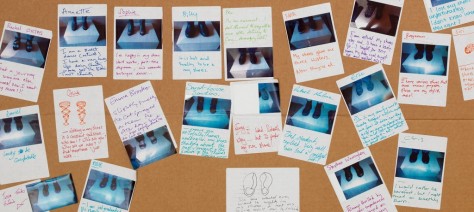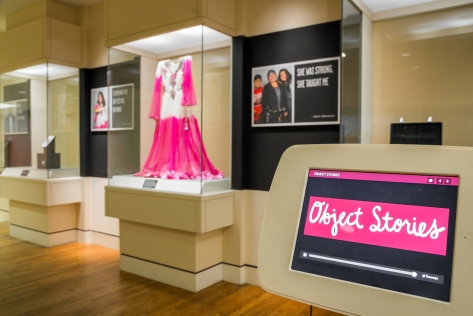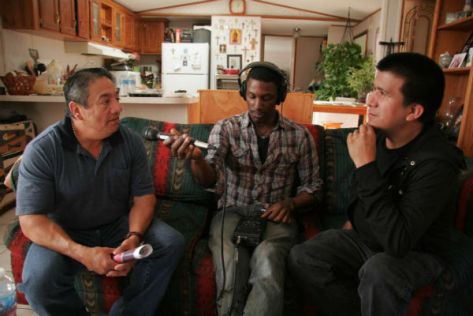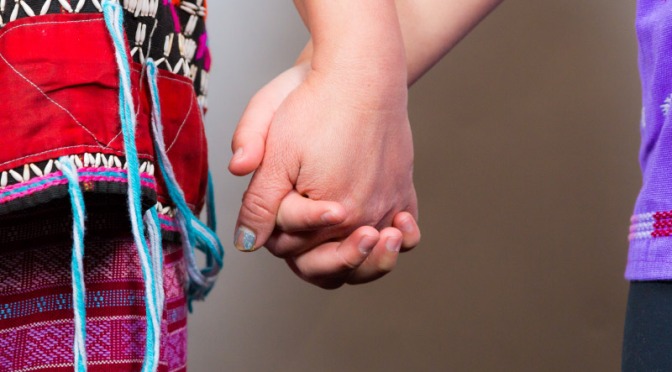Written by Mike Murawski
“We are in more urgent need of empathy than ever before.”
This quote has been on my mind often over the past days, weeks, months, and sadly, years—as senseless acts of violence and hatred hit the headlines at a numbing pace of regularity. This past Friday was no different, as we all awoke to the horrific news from Dallas, during a week when the country was already reeling from news of the deaths of Alton Sterling and Philando Castile. We’re also seeing an alarming spike in hate crimes and xenophobia in the UK after ‘Brexit’ that correspond in unsettling ways to divisive rhetoric and acrimonious tone of Republican nominee Donald Trump’s presidential campaign. All of this as we are still processing the Pulse nightclub attack in Orlando, where 49 individuals lost their lives.
I think in moments like these, it’s important for museums—and the people who work for them—to pause and reflect on the roles that we serve within our communities. Yes, museums are institutions that hold collections. But they can also serve a powerful role with our communities as active spaces for connection and coming together, for conversation and dialogue, for listening and sharing. Museums can be spaces for individual stories and community voices. They can be a space for acknowledging and reflecting on differences, and for bridging divides. They can be spaces for growth, struggle, love, and hope.
The words at the beginning of this post come from Roman Krznaric, author of Empathy: Why It Matters, and How to Get It and founder of the Empathy Library. Krznaric is among a growing chorus of voices who see an urgent need for empathy and human understanding in an era too often marked by violence, hatred, resentment, self-interest, and toxic political and social debates. In his TEDx Talk “How to Start an Empathy Revolution,” he defines empathy:
“Empathy is the art of stepping into the shoes of another person and looking at the world from their perspective. It’s about understanding the thoughts, the feelings, the ideas and experiences that make up their view of the world.”
In September 2015, Krznaric put these ideas into practice in the realm of museums with the development of the Empathy Museum, dedicated to helping visitors develop the skill of putting themselves in others’ shoes. Its first exhibit, “A Mile in My Shoes,” did quite literally that, setting up in a shoe shop where visitors are fitted with the shoes of another person, invited to walk a mile along the riverside while being immersed in an audio narrative of this stranger’s life, and then write a short story about it. With contributions ranging from a sewer worker to a sex worker, the stories covered different aspects of life, from loss and grief to hope and love.

Developing empathy has the potential to create radical social change, “a revolution of human relationships,” Krznaric states. So how can we spark this empathy revolution in museums?
Museums Are Us, Not It
I want to start by making an important foundational point about how we talk about museums. When we talk about them only as brick-and-mortar institutions or as ‘it’, it becomes easier to distance ourselves from the human-centered work we do. So it’s absolutely essential to remember that museums are made of people (yes, just like Soylent Green): from directors, board members, patrons, and curators to educators, guest services staff, registrars, conservators, security guards, volunteers, maintenance and facilities workers, members, visitors, etc. I am reminded of this by the Director of Learning at the Tate, Anna Cutler, whose memorable 2013 Tate Paper discussed institutional critique and cultural learning in museums. In it, she quotes artist Andrea Fraser:
“Every time we speak of the ‘institution’ as other than ‘us’ we disavow our role in the creation and perpetuation of its conditions.”
This is an important basis for any discussion of empathy and museums, since it defines the vision, mission, and work of a museum as the vision, mission, and work of the people who belong to that museum. So if we, myself included, say “museums must be more connected to their communities,” we’re really talking about what the people that make up the museum need to focus on – being more connected to our communities. We are inseparable from the institution, in other words. Any critique of museums is a critique of us; and any change needing to happen in museums is, therefore, a change that needs to start with us.
The Growing Role of Empathy in Museum Practice
Krznaric’s work with the Empathy Museum is but one small example of the types of civically-engaged, human-centered practices that have been instituted in an effort to expand the role that museums serve in building empathy and human connection in our communities. Staff working for museums across the globe are launching new efforts to bring people together, facilitate open dialogue, and elevate the voices and stories of marginalized groups to promote greater understanding.
For example, I continue to be amazed and inspired by the Multaqa project developed last year by Berlin’s state museums, which brings in a group of refugees from Iraq and Syria to serve as Arabic-speaking guides. The project title, Multaqa, means “meeting point” in Arabic. The tours are designed to give refugees and newcomers access to the city’s museums and facilitate the interchange of diverse cultural and historical experiences. The tours have been so popular, according to a recent report, that the organizers are looking to expand the program to include “intercultural workshops, which the Berlin public can also participate in.”
Here at the Portland Art Museum, the Object Stories initiative (which began back in 2010) has continued to embrace storytelling and community voices here in Portland. A recent exhibition that opened earlier this year featured powerful stories and personal objects from the local refugee community. The exhibition was co-created with Portland Meet Portland, a local non-profit focused on welcoming immigrants and refugees arriving in our city by creating mutually beneficial mentoring opportunities that promote cross-cultural learning, enhance work skills, and build trust.
The work of Portland Meet Portland and this Object Stories exhibition helped to highlight the important contributions that immigrants and refugees bring to their new homes here in Oregon, and also offered this area’s longer-term residents an opportunity to learn from these newcomers—their stories, resilience, and unique cultures. Visitors to the gallery (probably around 60,000 people) had the opportunity to listen to participants’ stories, leave a welcome message for these storytellers, and learn more about advocacy efforts and local non-profits working with immigrant and refugees in Portland (which ranks 11th among US cities resettling international refugees).

The Canadian Museum for Human Rights, an inspiring institution in so many ways, currently houses six different exhibits that explore the tragic story and legacy of the Indian Residential School system, one of Canada’s most pressing human rights concerns. As a national museum and hub of human rights education, the Museum has an important role to play in efforts towards reconciliation between Indigenous and non-Indigenous people in Canada. As is stated in the 2015 summary report of Canada’s Truth and Reconciliation Commission (TRC): “Through their exhibits, education outreach, and research programs, all museums are well positioned to contribute to education for reconciliation.” The team at the Canadian Museum of Human Rights is also working to keep the conversation alive and involve the voices of its communities, especially through its “Share Your Story” project that allows anyone to record their own story about human rights or listen to the individual experiences of others.
In their book Cities, Museums, and Soft Power, Gail Dexter Lord and Ngaire Blankenship discuss the human social behaviors of bridging and bonding that museums have the distinct potential to promote and amplify, especially through public programs, education, and exhibitions. Their final essay offers a comprehensive set of strategies for how museums can be of greater value to their cities and communities:
“Museums and cities have a strong role to play together in bridging and bonding. They bring people together at similar life stages … or with identity in common … where they can share their experiences. Museums also bridge among identities, offering a public place to bring different groups together around similar interests.” (p. 222)
The International Museum of Folk Art’s Gallery of Conscience, inaugurated in 2010, serves as truly unique and visionary example of how museums are experimenting in this area. The Gallery’s goal is to be an agent of positive social change by engaging history, dialogue, and personal reflection around issues of social justice and human rights. Since the gallery’s inception, exhibitions in this space have explored how traditional artists come together in the face of change or disaster to provide comfort, counsel, prayer, and hope through their art. This focus has earned the space membership in the International Coalition of the Sites of Conscience.
Exhibitions in the Gallery of Conscience are “community-driven, co-created, collaborative, participatory, and cumulative,” according to a press release. “Visitors and community members become part of the conversation from the very beginning—helping to shape the exhibitions and contribute to the dialogue throughout the exhibition’s run.” In 2013-14, the Gallery’s exhibition “Let’s Talk About This” focused on folk artists’ responses to HIV/AIDS through artist and visitor participation, community programs, and a digital storytelling project with LGBTQ youth developed in partnership with N’MPower and Youth Media Project. The oral histories that were collected were incorporated into the exhibition through listening stations, and also became part of the dialogue-based programs related to the exhibition.

Building a Broader Culture of Advocacy
The type of museum practice I’ve highlighted is certainly not new. Many of us read about this work in museum blogs (such as Incluseum, Thinking About Museums, Visitors of Color, Queering the Museum, Brown Girls Museum Blog, etc.) and emails from the Center for the Future of Museums or Museum Hack. Many of us work on programs like these ourselves. But what concerns me is that across much of this practice, I find a lack of a broader institutional culture of support. Too many community-based projects like the ones I mention above end up being relegated to education staff, isolated from the core mission of an institution, or left entirely invisible. And this lack of supports extends beyond the walls of the museum. When journalists, scholars, and critics write about museums and exhibitions, they frequently ignore or denigrate the spaces that invite visitor engagement and community participation. There are even individuals in my own field of museum education who refer to empathy-building practices and affective learning strategies as too “touchy feely.”
We museum people need to work together to build a stronger, collective culture of support and advocacy for museum practice based in empathy, inclusion, and social impact. This is some of the most meaningful, relevant work happening in museums right now. People across our institutions—not just educators but directors, curators, marketing staff, board members, donors, etc.—need to be publicly and visibly proud of the programs, exhibitions, and projects that actively embrace individual stories, dialogue about provocative questions, and the diverse and rich lived experiences of those living in our communities. More comprehensive support for this work can lead to an expanded focus on social impact and community engagement in a museum’s strategic goals and mission, in its exhibition and program planning process, and in its allocation of resources.
So let’s all be more proud of the work we’re doing in museums to bring people together and learn more about ourselves and each other — from tiny one-off gatherings and events to much larger sustained initiatives.
Time for an Empathy Revolution in Museums
How do we start an empathy revolution in museums? How do we more fiercely recognize and support the meaningful work that museum professionals are already leading to support open dialogues around the challenging, relevant issues of our time? And how do we radically expand this work to build a stronger culture of empathy within museums — one that measures future success through our capacity to bring people together, foster conversations, and contribute to strong and resilient communities?
In 2013, the Museums Association of the UK launched its Museums Change Lives campaign, establishing a set of principles based on research, conferences sessions, online forums, open public workshops, and discussions with charities and social enterprises. I think the core principles they developed from their vision for the social impact of museums (a must read!) are worth sharing to move this discussion forward and enact change:
- Every museums is different, but all can find ways of maximizing their social impact.
- Everyone has the right to meaningful participation in the life and work of museums.
- Audiences are creators as well as consumers of knowledge; their insights and expertise enrich and transform the museum experience for others.
- Active public participation changes museums for the better.
- Museums foster questioning, debate, and critical thinking.
- Good museums offer excellent experiences that meet public needs.
- Effective museums engage with contemporary issues.
- Social justice is at the heart of the impact of museums.
- Museums are not neutral spaces.
- Museums are rooted in places and contribute to local distinctiveness.
These principles, as with much of their vision, are inspiring — but too often we stop there, feeling inspired but lacking action. The Museums Association report continues, “It’s time for your museum to respond to hard times by making a bigger difference. It’s time for you to play your part in helping museums change people’s lives.” The report concludes with a pretty spot-on set of 10 actions that will help your museum improve its social impact. Here is a slightly abbreviated, edited list:
- Make a clear commitment to improve your museum’s social impact (ie. having strategic goals).
- Reflect on your current impacts; listen to users and non-users; research local needs.
- Research what other museums are doing.
- Seek out and connect with suitable partners.
- Work with your partners as equals.
- Allocate resources.
- Innovate and be willing to take risks.
- Reflect on and celebrate your work. Learn from and with partners and participants.
- Find ways for partners and participants to have a deep impact on your museum. Bring more voices into interpretation and devolve power.
- Strive for long-term sustained change based on lasting relationships with partners and long-term engagement with participants.
Print these out, put them on your office wall, bring them to staff meetings, share these with your visitors and audiences, and have some open conversations about the “so what” of museums. Take these principles and action steps seriously. Build a broader team to advocate for the work you’re already doing at your institution; rethink existing programs; and bravely propose new projects and partnerships that better serve your community. See how a human-centered focus on empathy and social impact might change your own practice, your museum, and your community.
“The best museums are now striving to realise their full potential for society and are far more than just buildings and collections. They have two-way relationships with communities…. They are becoming increasingly outward looking, building more relationships with partners. They are welcoming more people as active participants.” (Museums Change Lives)
Let’s be a part of making this happen!
* * *
About the Author
 MIKE MURAWSKI: Founding author and editor of ArtMuseumTeaching.com, museum educator, and currently the Director of Education & Public Programs for the Portland Art Museum. Mike earned his MA and PhD in Education from American University in Washington, DC, focusing his research on educational theory and interdisciplinary learning in the arts. Prior to his position at the Portland Art Museum, he served as Director of School Services at the Saint Louis Art Museum as well as coordinator of education and public programs at the Mildred Lane Kemper Art Museum at Washington University. Mike has been invited to lead workshops, lectures, panels, and training sessions at various institutions, including the Aspen Art Museum, Crocker Art Museum, the Museum of Contemporary Art in San Diego, Los Angeles County Museum of Art, National Gallery of Art, Nelson Atkins Museum of Art, Philadelphia Museum of Art, and Phoenix Art Museum, among others. He is passionate about how we can come to see museums as agents of change in their communities as well as creative sites for transformative learning and social action. Mike’s postings on this site are his own and don’t represent the Portland Art Museum’s positions, strategies, or opinions.
MIKE MURAWSKI: Founding author and editor of ArtMuseumTeaching.com, museum educator, and currently the Director of Education & Public Programs for the Portland Art Museum. Mike earned his MA and PhD in Education from American University in Washington, DC, focusing his research on educational theory and interdisciplinary learning in the arts. Prior to his position at the Portland Art Museum, he served as Director of School Services at the Saint Louis Art Museum as well as coordinator of education and public programs at the Mildred Lane Kemper Art Museum at Washington University. Mike has been invited to lead workshops, lectures, panels, and training sessions at various institutions, including the Aspen Art Museum, Crocker Art Museum, the Museum of Contemporary Art in San Diego, Los Angeles County Museum of Art, National Gallery of Art, Nelson Atkins Museum of Art, Philadelphia Museum of Art, and Phoenix Art Museum, among others. He is passionate about how we can come to see museums as agents of change in their communities as well as creative sites for transformative learning and social action. Mike’s postings on this site are his own and don’t represent the Portland Art Museum’s positions, strategies, or opinions.


Thanks, Mike Agree with all you say. You might be interested in the Maturity Model we have developed as a tool for institutional empathy. See http://www.Empatheticmuseum.weebly.com and click on Maturity Model. Thanks for anything you can do to get the word out. Best. Gretchen
Thanks for sharing that resources, Gretchen! I know that this is an issue that you are passionate about, but I had not seen this Maturity Model yet. I especially love the “Community Resonance” rubric. I’ll definitely share this, and include in future discussions of this issue. Awesome stuff!
So glad to read this today — also want to make readers aware of a new resource, due out next month: Fostering Empathy Through Museums, edited by Elif Gokcigdem. Elif has a blog of the same name that you might find of interest: https://greatolivetree.wordpress.com/2015/09/25/announcing-an-upcoming-book-fostering-empathy-through-museums/
thank you for all the resources you’ve shared here
Susan, thanks for sharing. I knew this book was being developed, and I’m so glad to hear that it comes out in the next month or two (great timing). I just pre-ordered my copy now. Really important resource!
Take a look at the Children’s Museum of Pittsburgh’s traveling exhibit, XOXO: An Exhibit About Love & Forgiveness. It is so important that children are being exposed to empathy, kindness, love, and forgiveness. This exhibit does a beautiful job at inviting visitors to express themselves and explore their emotions.
http://www.pittsburghkidsxoxo.com
Jenna, this looks fantastic! I appreciate you sharing this exhibit. This reminds me how important multi-sensory experiences are to affective learning, for children and people of all ages. It also makes me think about how important “empathy” is as an objective for school tours and programs in museums, not just with adults.
This exhibit will be at Portland Children’s Museum next winter. Mike, let me know if you want to arrange a visit!
Dear Mike –Thank you for this timely and insightful call to action. I wholeheartedly agree with your view that the time is “now” to employ and foster empathy through museums. As Susan mentioned in her comments above, our upcoming book titled “Fostering Empathy Through Museums” offers fifteen case studies from a variety of museums. While I agree that institutional empathy is critical for all kinds of public institutions, I also think museums can offer a unique service to the society by fostering empathy as an “outcome” of a museum experience. More on the “empathy-building through museums” initiative can be found at: https://greatolivetree.wordpress.com/ and at a recently launched Facebook community: “Fostering Empathy Through Museums.” Thank you for highlighting this important issue with your informative and inspiring essay.
Thank you for your kind words, Elif. I was so glad to hear about the upcoming book — sounds really important, and I’ve already pre-ordered a copy. As an educator and teacher myself, I completely agree that empathy should be a core outcome of the museum experience. My post was originally about empathy in museum teaching, but then the world turned upside down and I wanted to write something a bit broader first. I still hope to write a follow-up essay focusing more on my own personal pedagogy around empathy, vulnerability, and human connection. Thanks for your comment, and I hope we can keep in touch about this! Cheers!
Hi Mike
For a cornucopia of resources on empathy see the Center for Building a Culture of Empathy. http://CultureOfEmpathy.com
We invite you to join the International Empathy Trainers Association
http://j.mp/Empathy-Trainers-Association
also see my interviews with
Creating the Empathetic Museum with Gretchen Jennings
http://j.mp/R4GYsb
warmly
Edwin
Director: Center for Building a Culture of Empathy
Edwin, thanks fort these additional resources!
Really enjoyed reading this Mike, thanks very much for sharing and highlighting some new examples! (Thanks also to other comment writers for further ideas and links.) I’m totally up for being part of an Empathy revolution. We use human-centred design methods and tools extensively in our museums and share them widely with others, so maybe that’s a start… Let me know if you’re ever passing by Derby, UK! V best, Hannah Fox
Thanks, Hannah! I learned about your Human-Centered Design Handbook from Dana Mitroff Silvers — sounds amazing! If I’m ever in the UK, I will most certainly stop by and let you know. Cheers!
Yes, same concept as sleeping in slave dwellings with the descendants of the enslaved and enslavers.
Love this and the conversation that it is already sparking (in the comments section). Thanks for speaking about such an important and crucial topic.
Great discussion. I recommend checking out the Welcoming Guidelines that the AAM LGBTQ Alliance published this spring:
https://www.aam-us.org/docs/default-source/professional-networks/lgbtq_welcome_guide.pdf?sfvrsn=2
Thanks, Michael. We posted that AAM resource here on ArtMuseumTeaching back in June, and it’s great to make the connection with these ideas of empathy and inclusion. I hope people do check it out.
Thank you, Mike! We are doing some work in Portland over the next two years and I would love to stop by and say hello one day.
Thanks for bringing so many insights about relevance, empathy and social impact of museum. I think that to root these values in museums practices we need to start them inside our own team. These practices of listening, considering and acting about one needs has to be part of our everyday life with our work partners. If we achieve that, naturally these initiatives with visitors and so on will be valued by all the institution and will become a natural consequence of how things happen on the backstage.
Hi Mike. I heard your speak at the MuseumNext conference in NYC earlier this week. It was captivating. You read the introductory panel from an exhibition at your museum that was written by Native people of the region. Could you please send me the text as it may serve as inspiration/aspiration for something similar we might do at the National Museum of the American Indian in NYC? Best, Johanna Gorelick (gorelickj@si.edu)